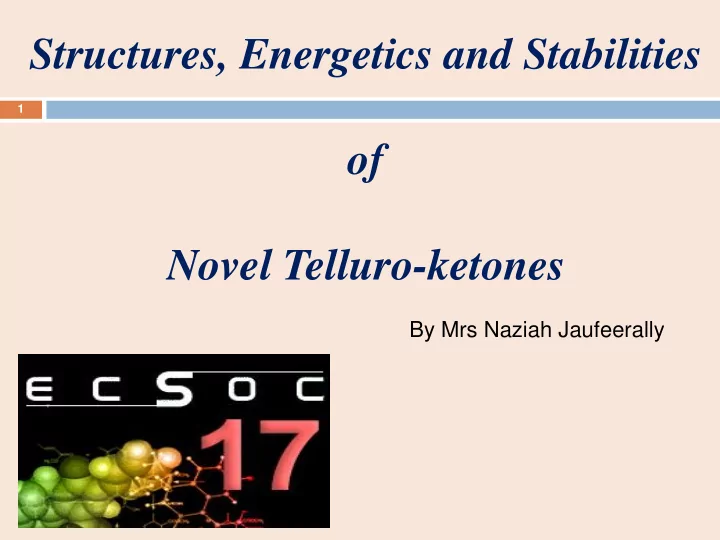

Structures, Energetics and Stabilities 1 of Novel Telluro-ketones By Mrs Naziah Jaufeerally
Myself Mrs Naziah Jaufeerally Prof Ponnadurai Ramasami PhD scholar 2
Target Molecules Telluroformaldehyde/ Silanetellone/ Germanetellone 3
Why the study of Heavy Congeners of H 2 C=O ? mainly to check the reliability of quantum mechanical computing methods C=O group- important organic moiety in industry and biology F 2 C=O Cl 2 C=O X 2 C=O (X=F and Cl) major products of photolysis of halomethanes in presence of oxygen 4 http://www.google.mu/imgres?imgurl=http://www.windows2universe.org/earth/Atmosphere/images/stratosphere_diagram_sm.jpg&imgrefurl=http://www.windows2univer se.org/earth/Atmosphere/stratosphere.html&usg=__gmJvTdnP7rvzHVMpg1vmjQ7ywZA=&h=400&w=300&sz=29&hl=en&start=6&zoom=1&tbnid=8aSTvfIoWlzLbM:&tb nh=124&tbnw=93&ei=7QPfT_rBKcyzhAeeqqH8CQ&um=1&itbs=1
Thio- and Seleno- analogues – Important intermediates in sulfur and selenium containing molecules – Composition of nucleic acid and ribose sugars of some active metabolites – Useful anti-tumour drugs 5
But the literature of telluro-ketones is scarce. Despite Telluroformaldehyde complexes were first synthesized in 1983. 6
H Telluroformaldehyde C Te H 7
However, nowadays there is a quest for tellurium containing compounds or tellurocarbonyl compounds. 8
Importance of Telluro-ketones 9
Importance of Telluro-ketones 10
Monomeric H 2 Si=S has reached the STARS! 11 http://www.scientificamerican.com/media/inline/52A1F834-FD5E-0493-FBBDE8D6A42F2DDE_1.jpg&imgrefurl=http://www.scientificamerican.com/article.cfm%3Fid%3Dthe-night-sky- will-fade-to-black&usg=__RPuI7YGKRkWEw8uIansvoBD89kM=&h=320&w=320&sz=20&hl=en&start=5&zoom=1&tbnid=V8MgZx4YbIUEOM:&tbnh=118&tbnw=118&ei=3KfqT- zkOcborQfVpNC5BQ&prev=/search%3Fq%3Dnight%2Bsky%26hl%3Den%26site%3Dimghp%26tbm%3Disch&itbs=1
Why Limited literature for Telluro-ketones? Theoretical exploration has been scarce due to: • Lack of well-tested basis sets for Te atom • Limited computing resources 12
Why Limited literature for Telluro-ketones? The lack of experimental studies is often ascribed to: • The semipolar nature of the A=E bond (A=C, Si and Ge; E=O, S, Se and Te) • High tendency for the A=E to open up and undergo intermolecular reactions 13
Stable Monomeric Germanone 14
Objectives of this research work Molecular geometries 15 Isomeriz- Ionization ations Potentials Telluro- ketones Electron Kinetics Affinities Singlet- HOMO- Triplet LUMO Splittings gaps
Our Findings 16
17
Our Findings The kinetic and thermodynamic stabilities of the telluro-ketones were always questioned by reviewers. 18
Back to literature … How others have stabilized some of the known heavy ketones? Has any stable telluro-ketone been synthesized and isolated so far? 19
20
21
22
Conclusions from literature … Heavy ketones and telluro-ketones synthesized and isolated so far are based on the kinetic stabilization of the A=E bond by the use of bulky rigid protecting groups. 23
Does this means that the simple, unprotected telluro-ketones are unstable compared to those kinetically protected ones? 24
Our Response to the Queries 25
Our Response to the Queries 26
Our Response to the Queries 27
Our Response to the Queries 28
Our Response to the Queries 29
Our Response to the Queries 30
Further Objectives Existence of Telluro-ketones is Not a Myth But a Reality! 31
In view of this, we are currently working on the following manuscript
33
34
Further Studies Stabilization of the C=Te, Si=Te and Ge=Te double bonds With the help of rigid and bulky protecting groups Modeled from the 1 st synthetic success of germanetellone reported in JACS 35
Stabilization of the C=Te, Si=Te and Ge=Te double bonds With the help of rigid and bulky protecting groups Modeled from the 1 st synthetic success of germanone reported in Nature Chemistry 36
Stabilization of the C=Te, Si=Te and Ge=Te double bonds With the help of Lewis donor-acceptor ligands 37
Conclusions Since state-of-the-art computations have been carried out, findings of this work can serve as a good reference and assist experimentalists to synthesize, characterize and further explore the properties of these novel telluro-ketones 38
Acknowledgements I gratefully acknowledge: the organising committee of 17 th ECSOC Our collaborators: Prof HF Schaefer, Prof G Frenking and Dr H Abdallah the University of Mauritius the computing facility of Gridchem the Tertiary Education Commision (TEC) 39
40 Thank You
Recommend
More recommend